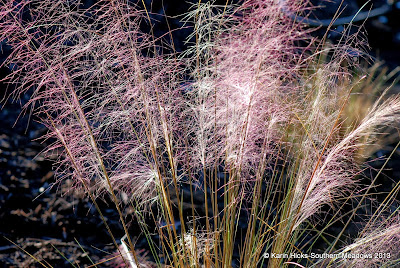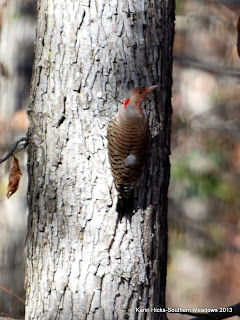Lessons Learned from Fall Garden 2013
Fall is often the busiest time at Southern Meadows. This fall was spent digging lots of holes for all the plants that we purchased at the local plant sales and nurseries. We ordered a flatbed of rocks to finish some hardscape projects (for detail on this project see my post here) and started landscaping the flower beds in front of our new patio.
But what I learned from my garden this fall is that despite all the things on the to-do list, I still need to take time for reflection and quiet in the garden. This is when I notice the little things that are the most important aspects of gardening when it comes to wildlife. What I observed this fall is that our efforts to support wildlife are finally paying off. The bird feeders were filled but remained untouched by the birds and squirrels because they were busy foraging in the landscape.
I saw wildlife in my garden that I never notice before like this yellow-shafted flicker;
and, this brightly colored, marbled orb weaver.
I decided that its okay if I don't get around to harvesting all our fruits and vegetables because if I don't others will benefit too.
I also learned that butterflies can survive some pretty cold temperatures if they hunker down in the leaf litter or find refuge in bark, rocks or sheltered crevices. A cold front moved in unseasonably early this year and took out most of the nectar sources for these butterflies. Putting out supplemental food is essential for them to survive such conditions on their southward migration. Think about putting out some nectar using a natural sponge and sugar water (1 part sugar to 4 parts water) in a shallow dish if this occurs in your area. Butterflies will also pull food from rotting fruit. Cutting up your Jack-O-Lantern is a great way to provide food for some butterflies.
Bringing in plants that are not hardy is one of the last things we do to put the garden to bed for the winter months. The pots with the lemon, lime and calamondin plants are large and heavy. It is always challenging to find a good spot for these plants so they can get their required 5 hours of sun a day, preferably 10 hrs. We've learned that they tend to suffer if they don't get the right light requirements so last year we provided supplemental lighting; but, this year my husband had the brilliant idea of putting them on rolling furniture movers. We've placed them in a sunny window in the garage and we can now move the plants outdoors on those sunny, warmer winter days.
What lessons have you taken away from your garden this Fall? Think about joining in this seasonal meme. All the details are available at Plant Postings (Lessons Learned) and Gardens Eye View (Seasonal Celebrations). Please come back for my next post where I will highlight some of the ways we enjoy celebrating the winter season.
But what I learned from my garden this fall is that despite all the things on the to-do list, I still need to take time for reflection and quiet in the garden. This is when I notice the little things that are the most important aspects of gardening when it comes to wildlife. What I observed this fall is that our efforts to support wildlife are finally paying off. The bird feeders were filled but remained untouched by the birds and squirrels because they were busy foraging in the landscape.
I saw wildlife in my garden that I never notice before like this yellow-shafted flicker;
and, this brightly colored, marbled orb weaver.
I decided that its okay if I don't get around to harvesting all our fruits and vegetables because if I don't others will benefit too.
I also learned that butterflies can survive some pretty cold temperatures if they hunker down in the leaf litter or find refuge in bark, rocks or sheltered crevices. A cold front moved in unseasonably early this year and took out most of the nectar sources for these butterflies. Putting out supplemental food is essential for them to survive such conditions on their southward migration. Think about putting out some nectar using a natural sponge and sugar water (1 part sugar to 4 parts water) in a shallow dish if this occurs in your area. Butterflies will also pull food from rotting fruit. Cutting up your Jack-O-Lantern is a great way to provide food for some butterflies.
Bringing in plants that are not hardy is one of the last things we do to put the garden to bed for the winter months. The pots with the lemon, lime and calamondin plants are large and heavy. It is always challenging to find a good spot for these plants so they can get their required 5 hours of sun a day, preferably 10 hrs. We've learned that they tend to suffer if they don't get the right light requirements so last year we provided supplemental lighting; but, this year my husband had the brilliant idea of putting them on rolling furniture movers. We've placed them in a sunny window in the garage and we can now move the plants outdoors on those sunny, warmer winter days.
What lessons have you taken away from your garden this Fall? Think about joining in this seasonal meme. All the details are available at Plant Postings (Lessons Learned) and Gardens Eye View (Seasonal Celebrations). Please come back for my next post where I will highlight some of the ways we enjoy celebrating the winter season.







.png)
